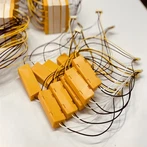The inspection and maintenance of drill pipes are crucial for ensuring their safety, reliability, and performance during drilling operations. Regular inspections and appropriate maintenance practices help identify potential issues early and extend the lifespan of the drill pipes. Below are standard procedures for inspecting and maintaining drill pipes:
1. Visual Inspection:
Conduct a visual inspection of the drill pipes before and after each use to check for visible damage, including dents, cracks, and wear.
Look for signs of corrosion, rust, or pitting on the external surface of the pipes.
Check the threads for signs of damage, galling, or excessive wear.
2. Non-Destructive Testing (NDT):
Periodically perform non-destructive testing, such as ultrasonic testing (UT) and magnetic particle testing (MT), to detect internal and surface defects that may not be visible.
UT can identify issues like internal cracks and wall thickness variations.
MT is effective at detecting surface cracks and discontinuities.
3. Thread Inspection:
Inspect the threads of the drill pipes and the tool joints carefully.
Ensure that the threads are clean and free from debris.
Check for thread galling, which can lead to poor connections and potential thread failure.
4. Hardbanding Inspection:
If the drill pipes have hardbanding applied to the tool joint shoulders and box ends, inspect the hardbanding for wear and damage.
Replace hardbanding if it becomes excessively worn or damaged.
5. Measurement and Calibration:
Periodically measure and calibrate the drill pipe dimensions, including the O.D., I.D., and wall thickness, to ensure they are within acceptable tolerances.
6. Cleaning:
Clean drill pipes thoroughly after each use to remove drilling mud, debris, and contaminants that can lead to corrosion.
Ensure that the interior of the pipes is free from residual drilling fluids.
7. Preservation:
Apply a protective coating, such as a rust inhibitor or oil, to the exterior surface of the drill pipes when they are not in use or during storage to prevent corrosion.
8. Lubrication:
Lubricate the threads and tool joint connections with a suitable thread compound to reduce friction and prevent galling during assembly and disassembly.
9. Storage:
Store drill pipes in a dry, well-ventilated area away from moisture and corrosive substances.
Properly secure and support the pipes to prevent deformation or damage.
10. Record Keeping:
Maintain detailed records of inspections, maintenance, and any repairs or replacements performed on the drill pipes.
Track the service history of each drill pipe to monitor its condition over time.
11. Repair and Replacement:
Promptly repair or replace any drill pipes that exhibit significant damage, defects, or wear that could compromise their structural integrity.
12. Certification:
Ensure that the drill pipes are certified to meet industry standards, such as API 5DP, and that the certification is up to date.
13. Training:
Train personnel involved in handling, inspecting, and maintaining drill pipes to ensure they are knowledgeable and skilled in proper procedures.
Regular inspections and maintenance are essential to prevent equipment failures and downtime during drilling operations. Adhering to industry best practices and standards is crucial for the safe and efficient use of drill pipes in oil and gas exploration and other drilling applications.
Production inspection and on-site maintenance of Drill Pipe are crucial. Vigor's technical team, with years of field experience, knows that high-quality products save significant time on-site. That's why we are dedicated to delivering the highest quality products and the strictest inspections to ensure optimal performance in the field. If you're interested in Vigor's products and services, please don't hesitate to reach out for top-notch solutions and personalized support tailored to your needs.
For more information, you can write to our mailbox info@vigorpetroleum.com & mail@vigorpetroleum.com






